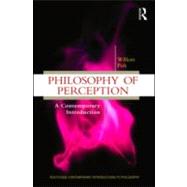
| Acknowledgments | p. xi |
| Introduction: Three key principles | p. 1 |
| Overview | p. 1 |
| Three key principles | p. 3 |
| Conclusion | p. 9 |
| Questions | p. 9 |
| Notes | p. 9 |
| Sense datum theories | p. 11 |
| Overview | p. 11 |
| The Phenomenal Principle and misleading experiences | p. 11 |
| Sense data and the Common Factor Principle | p. 13 |
| The time lag argument | p. 15 |
| Sense datum theory formalized | p. 16 |
| Sense datum theory and the two hats | p. 18 |
| Sense datum theory and the Representational Principle | p. 23 |
| The sensory core theory | p. 23 |
| Percept theory | p. 24 |
| Sensory core theory, percept theory, and the two hats | p. 27 |
| Metaphysical objections to mental objects | p. 29 |
| Questions | p. 30 |
| Notes | p. 30 |
| Further reading | p. 31 |
| Adverbial theories | p. 33 |
| Overview | p. 33 |
| Adverbialism | p. 36 |
| Adverbialism and metaphysics | p. 37 |
| The many property problem | p. 39 |
| The complement objection | p. 43 |
| Adverbialism and the two hats | p. 44 |
| Questions | p. 47 |
| Notes | p. 47 |
| Further reading | p. 48 |
| Belief acquisition theories | p. 51 |
| Overview | p. 51 |
| Perception as the acquisition of beliefs | p. 52 |
| Belief acquisition theory and the two hats | p. 54 |
| Perception without belief acquisition | p. 56 |
| Perception, belief, and our conceptual capacities | p. 59 |
| Acquiring new concepts | p. 61 |
| Blindsight | p. 63 |
| Questions | p. 63 |
| Notes | p. 63 |
| Further reading | p. 64 |
| Intentional theories | p. 65 |
| Overview | p. 65 |
| Varieties of intentionalism | p. 66 |
| Theories of perceptual content | p. 71 |
| How do experiences get their contents? | p. 77 |
| Representationalism and the two hats | p. 78 |
| Questions | p. 82 |
| Notes | p. 82 |
| Further reading | p. 85 |
| Disjunctive theories | p. 87 |
| Overview | p. 87 |
| The causal objection | p. 89 |
| Epistemological disjunctivism | p. 91 |
| Disjunctivism about metaphysics | p. 91 |
| Disjunctivism about content | p. 92 |
| Disjunctivism about phenomenology | p. 94 |
| Naive realism | p. 96 |
| Disjunctive theories of hallucination | p. 98 |
| Disjunctivism and illusion | p. 104 |
| Disjunctivism and the two hats | p. 106 |
| Questions | p. 108 |
| Notes | p. 109 |
| Further reading | p. 110 |
| Perception and causation | p. 113 |
| Overview | p. 113 |
| The causal theory of perception | p. 118 |
| Questions | p. 121 |
| Notes | p. 121 |
| Further reading | p. 123 |
| Perception and the sciences of the mind | p. 125 |
| Overview | p. 125 |
| Theoretical paradigms and their underlying assumptions | p. 126 |
| Important phenomena | p. 128 |
| Perception, cognition, and the phenomenal | p. 134 |
| Color vision and color realism | p. 140 |
| Questions | p. 145 |
| Notes | p. 145 |
| Further reading | p. 146 |
| Perception and other sense modalities | p. 149 |
| Overview | p. 149 |
| Individuating the senses | p. 149 |
| Touch, hearing, taste, and smell | p. 157 |
| How distinct are the senses? | p. 161 |
| Questions | p. 162 |
| Note | p. 163 |
| Further reading | p. 163 |
| References | p. 165 |
| Index | p. 175 |
| Table of Contents provided by Ingram. All Rights Reserved. |
The New copy of this book will include any supplemental materials advertised. Please check the title of the book to determine if it should include any access cards, study guides, lab manuals, CDs, etc.
The Used, Rental and eBook copies of this book are not guaranteed to include any supplemental materials. Typically, only the book itself is included. This is true even if the title states it includes any access cards, study guides, lab manuals, CDs, etc.